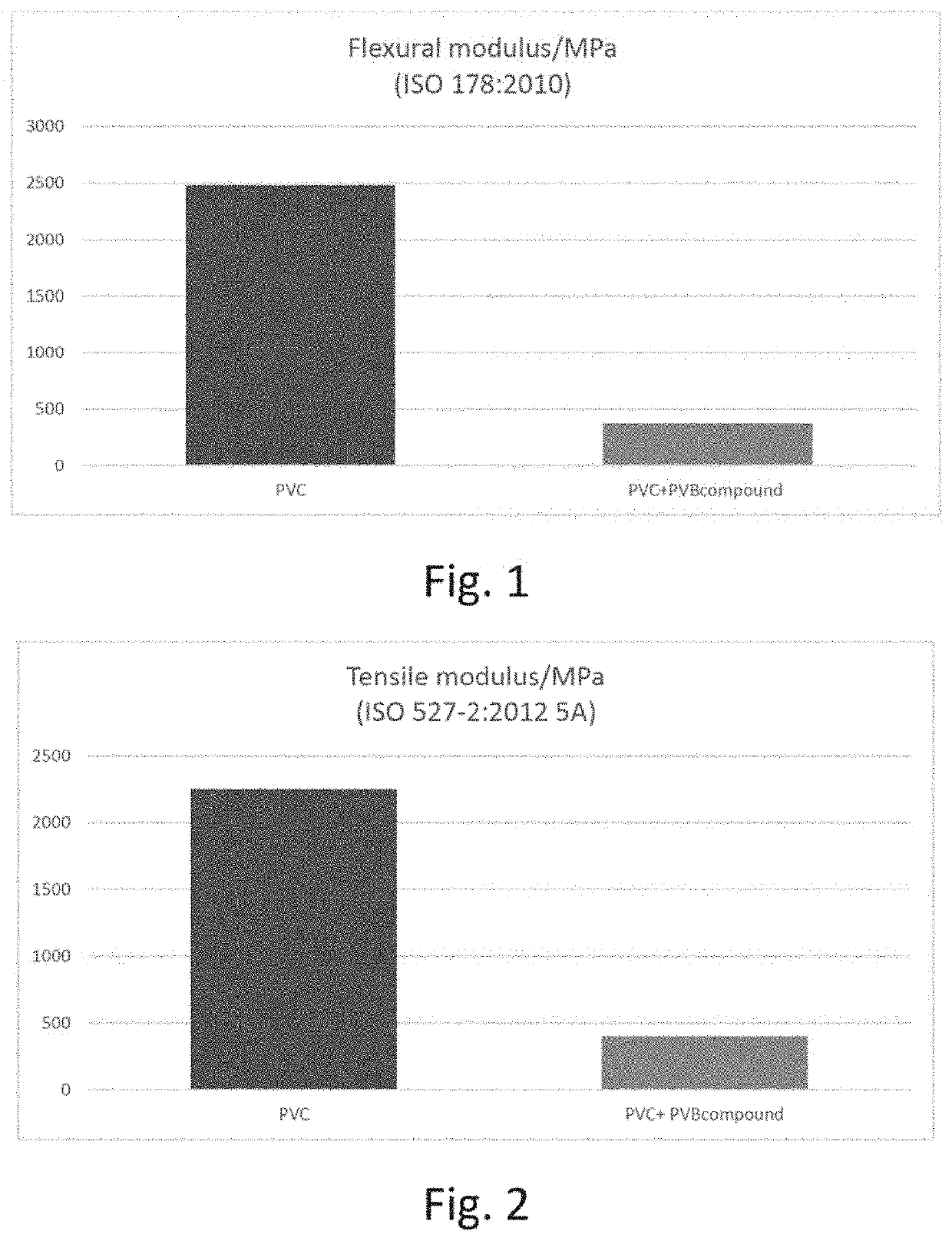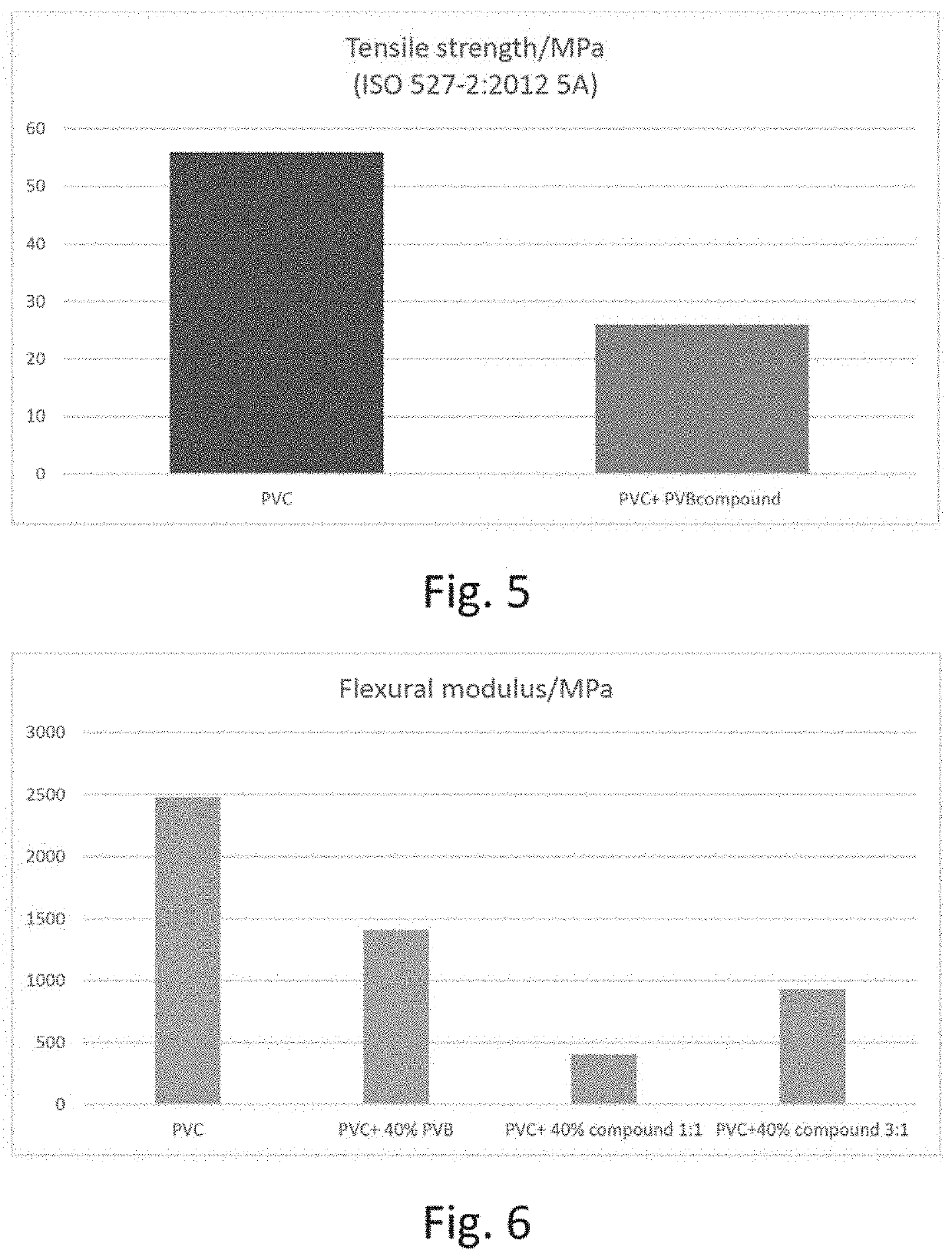Modification of virgin and/or recycled construction polymers, using poly vinyl butyral (PVB), or recycled PVB from industrial waste streams and an alloying copolymer
a technology of construction polymers and polymers, which is applied in the field of transformation of virgin and/or recycled construction polymers, using poly vinyl butyral (pvb), or recycling pvb from industrial waste streams and alloying copolymers, can solve the problems of increasing and reducing the brittleness of the produ
- Summary
- Abstract
- Description
- Claims
- Application Information
AI Technical Summary
Benefits of technology
Problems solved by technology
Method used
Image
Examples
example 1
on of Test Specimens
[0119]Processing: Compounds have been prepared on a roll mill at 195° C. for 12 minutes.
[0120]Plates have been produced on a Collin press at 180° C. and 150 bars for 3 minutes and then at 50° C. for 5 minutes for cooling. From these plates there has been prepared test samples according to the measures in the ISO and ASTM standards. The test specimens were cut from the plate in the required sizes described in the tests.
Compound Heat Stabilization
[0121]Antioxidants have been added to all compositions (1% PVC stabilizer as a Calcium-zinc complex (Baeropan™ MC 8850) and 0.4% PVB stabilizer Pentaerythritol tetrakis(3-(3,5-di-tert-butyl-4-hydroxyphenyl)propionate) (Irganox™ 1010)+0.2% Tris(2,4-ditert-butylphenyl)phosphite (Irgafos™ 168)
[0122]Reference specimens were made from pure PVC.
[0123]Test specimens according to the present invention were prepared from a plasticizer blend of 50% by weight of PVB with 50% by weight of Ethylene Copolymer Resin (Elvaloy™ 741) plasti...
example 2
[0124]Flexural modulus measured according to
[0125]ISO 178:2010 shows a decrease relative to the PVC of −85% on reference specimens as well as test specimens made according to example 1. Results.
[0126]Measurements have been done by testing specimens of rectangular cross-section being 80×10×4 mm, resting on two supports, being deflected by a loading edge acting on the specimen midway between the supports. The test specimen is deflected in this way at a constant rate at midspan until rupture occurs at the outer surface of the specimen or until a maximum strain of 5% is reached, whichever occurs first. During this procedure, the force applied to the specimen and the resulting deflection of the specimen at midspan are measured. The resulting softening / plasticization is interpreted as an evidence of the claimed function of the compound. The results are shown in FIG. 1 where the average values of flexural modulus is shown for the pure PVC reference specimen and the test specimen made with ...
example 3
[0127]Tensile modulus measured according to ISO 527-2:2012 shows a decrease relative to pure PVC. Measurements have been done using an extensometer measuring specimens 20 mm in the parallel parts and with an overall length of 35 mm. Thickness is 1 mm. The type of the specimens is referred to as 5 A.
[0128]The plasticizing of PVC by the plasticizer composition according to the present invention and as discussed in example 1 gives a change of −83%, see FIG. 2.
PUM
| Property | Measurement | Unit |
|---|---|---|
| temperatures | aaaaa | aaaaa |
| temperatures | aaaaa | aaaaa |
| temperatures | aaaaa | aaaaa |
Abstract
Description
Claims
Application Information
 Login to View More
Login to View More - R&D
- Intellectual Property
- Life Sciences
- Materials
- Tech Scout
- Unparalleled Data Quality
- Higher Quality Content
- 60% Fewer Hallucinations
Browse by: Latest US Patents, China's latest patents, Technical Efficacy Thesaurus, Application Domain, Technology Topic, Popular Technical Reports.
© 2025 PatSnap. All rights reserved.Legal|Privacy policy|Modern Slavery Act Transparency Statement|Sitemap|About US| Contact US: help@patsnap.com



